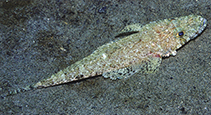
|
Thysanophrys chiltonae Schultz, 1966 Longsnout flathead |

|
|
photo by
Steene, R. |
| Family: | Platycephalidae (Flatheads) | |||
| Max. size: | 25 cm TL (male/unsexed) | |||
| Environment: | reef-associated; marine; depth range 0 - 100 m, non-migratory | |||
| Distribution: | Indo-Pacific: common and wide-ranging, from the Western Indian Ocean to Japan and Pacific Ocean islands to as far as the Marquesas. | |||
| Diagnosis: | Dorsal spines (total): 8-9; Dorsal soft rays (total): 11-12; Anal spines: 0-0; Anal soft rays: 12-12. Body and head mottled with dark brown and buff; fin rays with dark brown or black spots; dark brown saddle blotch on top of caudal peduncle (Ref. 4315). Least interorbital width going 3.8-7.2 times in diameter of eye. Base of lower opercular spine concealed by scales. Anterior 1-3, usually 3, lateral line scales bearing a small spine. Iris lappet bearing short branches with bifurcate tips. | |||
| Biology: | Inhabits sand areas adjacent to coral reefs (Ref. 9790). Seldom noticed for it buries itself in the sand (often partially). Usually in small groups (Ref. 48635). Feeds on crustaceans, crabs and prawns, also on fishes. | |||
| IUCN Red List Status: | Least Concern (LC); Date assessed: 04 March 2015 Ref. (130435) | |||
| Threat to humans: | harmless | |||
| Country info: |
|
|||